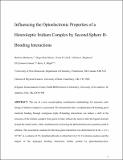Files in this item
Influencing the optoelectronic properties of a heteroleptic iridium complex by second-sphere H-bonding interactions
Item metadata
| dc.contributor.author | Balónová, Barbora | |
| dc.contributor.author | Rota Martir, Diego | |
| dc.contributor.author | Clark, Ewan | |
| dc.contributor.author | Shepherd, Helena | |
| dc.contributor.author | Zysman-Colman, Eli | |
| dc.contributor.author | Blight, Barry | |
| dc.date.accessioned | 2019-07-02T23:40:33Z | |
| dc.date.available | 2019-07-02T23:40:33Z | |
| dc.date.issued | 2018-07-03 | |
| dc.identifier | 253407447 | |
| dc.identifier | 33238648-4bee-4ac9-a48a-79d60c3bdc85 | |
| dc.identifier | 85049954276 | |
| dc.identifier | 000439250500064 | |
| dc.identifier.citation | Balónová , B , Rota Martir , D , Clark , E , Shepherd , H , Zysman-Colman , E & Blight , B 2018 , ' Influencing the optoelectronic properties of a heteroleptic iridium complex by second-sphere H-bonding interactions ' , Inorganic Chemistry , vol. In press . https://doi.org/10.1021/acs.inorgchem.8b01326 | en |
| dc.identifier.issn | 0020-1669 | |
| dc.identifier.other | ORCID: /0000-0001-7183-6022/work/56639106 | |
| dc.identifier.uri | https://hdl.handle.net/10023/18027 | |
| dc.description | BAB is grateful for financial support from University of Kent, University of New Brunswick and New Brunswick Foundation for Innovation. EZ-C thanks the University of St Andrews and EPSRC (EP/M02105X/1) for financial support. | en |
| dc.description.abstract | The use of a new second-sphere coordination methodology for emission color tuning of iridium complexes is presented. We demonstrate that a complimentary H-bonding guest molecule binding through contiguous triple H-bonding interactions can induce a shift in the emission of the iridium complex from green to blue without the need to alter the ligand structure around the metal centre, while simultaneously increasing the photoluminescence quantum yield in solution. The association constant for this host-guest interaction was determined to be Ka = 4.3 x 103 M-1 in a solution of 2% dimethylsulfoxide in chloroform by UV-Vis titration analysis and the impact of the hydrogen bonding interaction further probed by photoluminescence, electrochemical, and computational methods. Our findings suggest that directed self-assemblies are an effective approach to influencing emission properties of phosphorescent iridium (III) complexes. | |
| dc.format.extent | 1590722 | |
| dc.language.iso | eng | |
| dc.relation.ispartof | Inorganic Chemistry | en |
| dc.subject | QD Chemistry | en |
| dc.subject | DAS | en |
| dc.subject.lcc | QD | en |
| dc.title | Influencing the optoelectronic properties of a heteroleptic iridium complex by second-sphere H-bonding interactions | en |
| dc.type | Journal article | en |
| dc.contributor.sponsor | EPSRC | en |
| dc.contributor.institution | University of St Andrews. School of Chemistry | en |
| dc.contributor.institution | University of St Andrews. Organic Semiconductor Centre | en |
| dc.contributor.institution | University of St Andrews. EaSTCHEM | en |
| dc.identifier.doi | 10.1021/acs.inorgchem.8b01326 | |
| dc.description.status | Peer reviewed | en |
| dc.date.embargoedUntil | 2019-07-03 | |
| dc.identifier.grantnumber | EP/M02105X/1 | en |
This item appears in the following Collection(s)
Items in the St Andrews Research Repository are protected by copyright, with all rights reserved, unless otherwise indicated.

